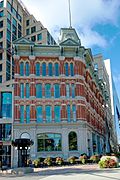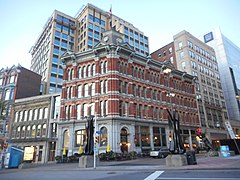
The Office of the Prime Minister and Privy Council building, formerly known as the Langevin Block, is an office building facing Parliament Hill in Ottawa, Ontario, Canada. As the home of the Privy Council Office and Office of the Prime Minister, it is the working headquarters of the executive branch of the Canadian government.
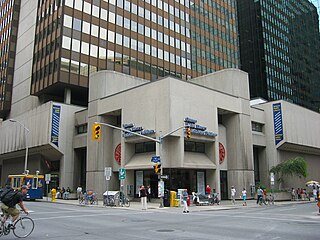
The Ottawa Public Library is the library system of Ottawa, Ontario, Canada. The library was founded in 1906 with a donation from the Carnegie Foundation.
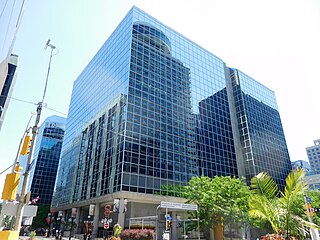
The C.D. Howe Building is an office tower in Ottawa, Ontario, Canada, that is the home of Innovation, Science and Economic Development Canada, the Office of the Auditor General and other smaller tenants. It was built by Olympia and York. The federal government sold the land to O&Y for a dollar and signed an agreement to lease the final building for a set rate until 2012. The eleven-story building was opened in 1978. The building site was once The Embassy Restaurant from 1953 to 1974.

The current Ottawa City Hall is the city hall of Ottawa, Ontario, Canada. The downtown complex consists of two connected buildings: a modern wing located on Laurier Avenue and a 19th-century heritage wing located on Elgin Street. Although City Hall has frontage on two major streets, the main entrance is on Laurier Avenue, and the municipal address is 110 Laurier Avenue West.

The Confederation Building is a office building in Ottawa, Ontario, Canada. Located just west of the Parliament Buildings at Bank Street and Wellington Street, it is generally considered part of Parliament Hill.

The Heritage Building is today part of Ottawa City Hall. It was originally built in 1874 as Ottawa Normal School and served as a teacher's college. The Gothic Revival building stands at Elgin Street and Lisgar and several extensions were added to the rear of the building.
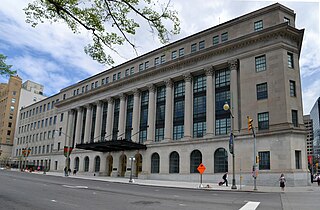
The Wellington Building is a Beaux-Arts architecture office building in Ottawa, Ontario, Canada. It was built between 1924 and 1927 as Canadian headquarters of the Metropolitan Life Insurance Company. The original structure was designed by D. Everett Waid; in 1959, the more restrained classical east wing of the building was added.

The Bytown Museum is a museum in Ottawa located in the Colonel By Valley at the Ottawa Locks of the Rideau Canal on the Ottawa River, just below Parliament Hill. Housed in the Commissariat Building, Ottawa's oldest remaining stone building, the museum provides a comprehensive overview of the origins of Bytown and its development and growth into the present city of Ottawa.

The first city hall for the city of Ottawa, Ontario, was built in 1849 on Elgin Street between Queen and Albert Streets.

The Ottawa Courthouse is a courthouse in Ottawa, Ontario, Canada. It is the main provincial court for the Ottawa area, and as such handles most of the region's legal affairs. The building is home to the civil, small claims, family, criminal, and district branches of the Ontario Superior Court of Justice. It is also home to the local land registry office. Some 1,000 people use the nine storey building each day.

The Dominion Public Building is a five-storey Beaux-Arts neoclassical office building built between 1926 and 1935 for the government of Canada at southeast corner of Front and Bay streets in Toronto, Ontario, Canada.

The Sir John A. Macdonald Building is a former bank building in Ottawa now owned by the federal government of Canada. It is located at 144 Wellington Street, at the corner of O'Connor Street, with a third frontage on Sparks Street, just in front of West Block of Parliament. Its façade indicates its former heritage as a Bank of Montreal branch location.

St Brigid's was a Roman Catholic church located in the Lower Town neighbourhood of Ottawa, Ontario, Canada. It was built to serve the English-speaking, Catholic population of the area. The church's closing was announced in 2006, and it was sold in 2007 and converted into Saint Brigid's Centre for the Arts, an Irish-Canadian heritage centre.

190 Coltrin Road is the residence of the High Commissioner of Pakistan in Ottawa, Ontario, Canada. It is located in the enclave of Rockcliffe Park amongst other prestigious ambassadorial residences. It was constructed in 1929 and is considered an important historical site, according to the Local Architectural Conservation Advisory Committee of Rockcliffe Park, under the Ontario Heritage Act (1974).
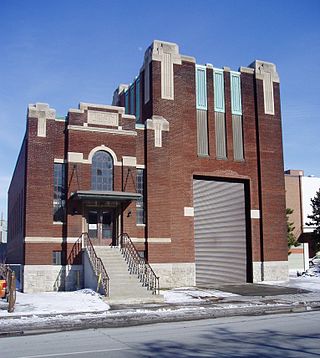
Hydro Ottawa Limited is a regulated electricity distribution company operating in the City of Ottawa and the Village of Casselman in Ontario, Canada. As the third-largest municipally-owned electrical utility in Ontario, Hydro Ottawa maintains the electricity distribution systems in the city, and serves over 335,000 residential and commercial customers across a service area of 1,100 square kilometres.
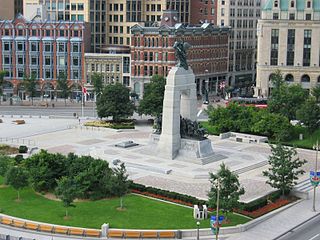
Confederation Square is an urban square in Ottawa, Ontario, Canada, and is considered the second most important ceremonial centre in Canada's capital city, after Parliament Hill. Roughly triangular in area, with Canada's National War Memorial at its centre and the Valiants Memorial at its periphery, the square is bounded by Wellington Street to the north and branches of Elgin Street to the east and west.

Central Chambers is a building at the corner of Elgin Street and Queen Street in Ottawa that is a National Historic Site. It is located at 42 to 54 Elgin Street, next to Bell Block. It faces the Canadian War Memorial at Confederation Square. Central Chambers was built between 1890 and 1893 and designed by John James Browne of Montreal, an example of Queen Anne Revival commercial architecture. Formerly serving as an office for the Canadian Atlantic Railway, it now houses the National Capital Commission.

Bell Block is a building in Ottawa, Ontario, Canada. It is located on 40 Elgin Street between the Central Chambers and Scottish Ontario Chambers. It was built in 1867 to a design by William Hodgson (1827–1904). Designated as a heritage property under Part IV of the Ontario Heritage Act, it was honoured with an "Award of Excellence" from the City of Ottawa.

Ralph Benjamin Pratt was a Canadian architect known for his work as a staff architect for the Canadian Pacific Railway and the Canadian Northern Railway, and for his work as a member of the firm Pratt and Ross with partner architect Donald Aynsley Ross.

